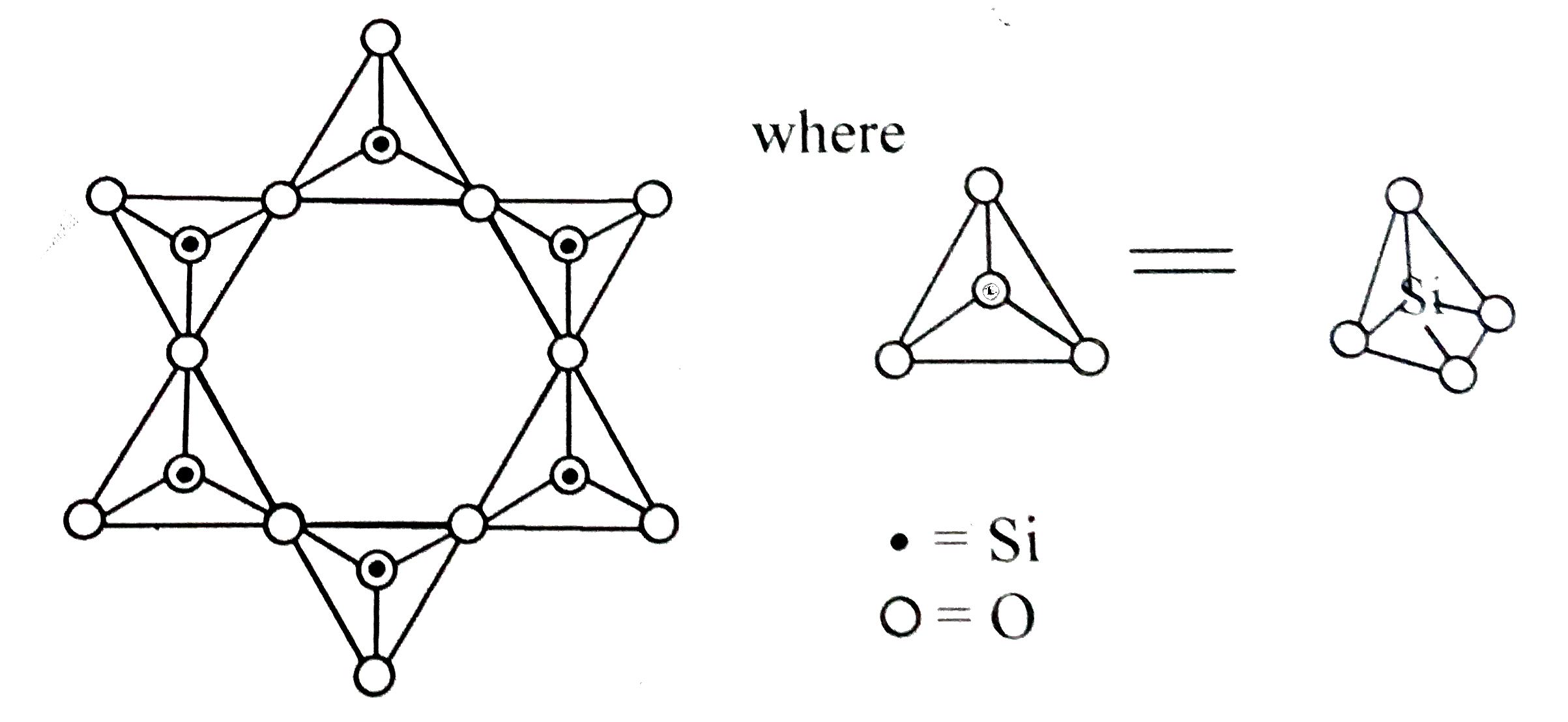In cyclic silicate ion Si6O12−18 the number of oxygen atoms shared.
The correct Answer is:6
To determine the number of oxygen atoms shared in the cyclic silicate ion Si6O12−18, we can follow these steps:
1. Understand the Structure of Cyclic Silicates:
- Cyclic silicates consist of silicate units where silicon atoms are surrounded by oxygen atoms. Each silicon atom is typically bonded to four oxygen atoms in a tetrahedral arrangement.
2. Identify the Number of Silicate Units:
- The given formula is Si6O12−18. This indicates that there are 6 silicon atoms in the structure.
3. Determine the Number of Oxygen Atoms in Each Silicate Unit:
- Each silicate unit (SiO4) shares oxygen atoms with adjacent silicate units. In a cyclic structure, each silicate unit shares 2 of its oxygen atoms with neighboring units.
4. Calculate the Total Number of Shared Oxygen Atoms:
- Since there are 6 silicate units, and each unit shares 2 oxygen atoms, the total number of shared oxygen atoms can be calculated as:
Total shared oxygen atoms=Number of silicate units×Oxygen atoms shared per unit
Total shared oxygen atoms=6×2=12
5. Adjust for Double Counting:
- However, since each shared oxygen atom is counted twice (once for each silicate unit it connects), we need to divide the total by 2 to find the actual number of unique shared oxygen atoms:
Unique shared oxygen atoms=122=6
Final Answer:
The number of oxygen atoms shared in the cyclic silicate ion Si6O12−18 is 6.
- Cyclic silicates consist of silicate units where silicon atoms are surrounded by oxygen atoms. Each silicon atom is typically bonded to four oxygen atoms in a tetrahedral arrangement.
- The given formula is Si6O12−18. This indicates that there are 6 silicon atoms in the structure.
- Each silicate unit (SiO4) shares oxygen atoms with adjacent silicate units. In a cyclic structure, each silicate unit shares 2 of its oxygen atoms with neighboring units.
- Since there are 6 silicate units, and each unit shares 2 oxygen atoms, the total number of shared oxygen atoms can be calculated as:
Total shared oxygen atoms=Number of silicate units×Oxygen atoms shared per unit
Total shared oxygen atoms=6×2=12
- However, since each shared oxygen atom is counted twice (once for each silicate unit it connects), we need to divide the total by 2 to find the actual number of unique shared oxygen atoms:
Unique shared oxygen atoms=122=6
The number of oxygen atoms shared in the cyclic silicate ion Si6O12−18 is 6.
Topper's Solved these Questions
- 14TH GROUP ELEMENTSBOOK - NARAYNACHAPTER - 14TH GROUP ELEMENTSEXERCISE - Previous Iit Question
4 Videos
- 14TH GROUP ELEMENTSBOOK - NARAYNACHAPTER - 14TH GROUP ELEMENTSEXERCISE - Multiple Answer Questions
1 Videos
- 14TH GROUP ELEMENTSBOOK - NARAYNACHAPTER - 14TH GROUP ELEMENTSEXERCISE - Matrix Matching type Questions
7 Videos
- 13TH GROUP ELEMENTSBOOK - NARAYNACHAPTER - 13TH GROUP ELEMENTSEXERCISE - Comphensive Type Question
22 Videos
- ACIDS & BASESBOOK - NARAYNACHAPTER - ACIDS & BASESEXERCISE - EXERCISE-III
43 Videos
Similar Questions
Knowledge Check
In [18] - crown-6, the number of oxygen atoms is
A18B6C12D24In [18] -crown-6, the number of oxygen atoms is :
A18B6C12D24the overall charge present on the cyclic silicate anion [Si6O18]n− is:
A6B12C18D24
Draw the structure of cyclic silicate containing Si6O12−18 ion.
View SolutionIn sheet silicate number of oxygen atoms involved in sharing are
View SolutionThe anion, (Si6O18)12− is present in
View SolutionIn P4O6andP4O10, the number of oxygen atoms bonded to each phosphorus atoms are reppectively-
View SolutionIdentify the cyclic silicate ion given in the figure below

View Solution
